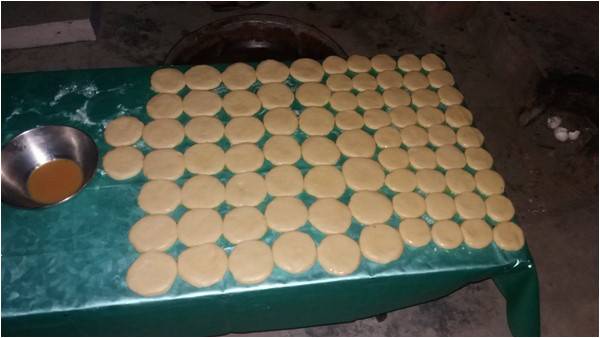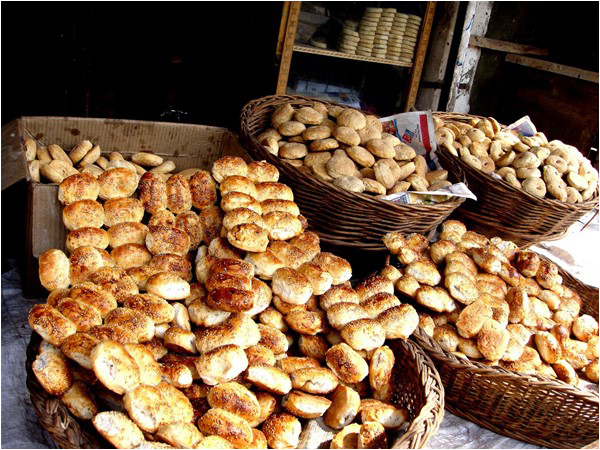
Wherever Kashmir is known for its unrivaled natural beauty – snow-covered
mountain peaks, blue rivers and rich culture – it is also famous for its mouthwatering traditional dishes like Rogan Josh, Dum Olav, Matschgand, Goshtaba, Modur Pulav, Aab Gosht and many more. Kashmir’s cultural products, including food and nonfood items, enjoy a certain global recognition.
I strongly believe that there is no replacement for two of Kashmir’s products: handmade Srinagar shawls and the Kulchas of Muzaffarabad, Azad Kashmir.
At present, I am going to discuss a round, slightly salty, biscuit-like snack known as a Kashmiri Kulcha. People eat it with tea in the morning as well as in the afternoon. It is famous for its taste and ingredients, available only in Muzaffarabad and the neighbouring Khyber-Pahtunkhwa district of Mansehra, at shops which bake and sell these Kulchay exclusively.
I often call it the Grandfather of the Biscuit because of its size and weight.
Kulchay are prepared in an oven made of clay (tandoor) – used for baking naan and roti – but the process is somewhat difficult and time-consuming. The recipe is complex – as no water involved in preparing the dough. The ghee does all the baking. Ghee and ‘laft maida’ (finely ground wheat flour) are the main ingredients used for preparing the kulchay, with just a little bit of baking powder and yeast. Three kilogrammes of wheat flour and one kilogramme of ghee are required for preparing one kilogramme of Kashmiri kulchay.
Muzaffarabad’s bakers (Karigars) are globally famous for their Kulcha-making skills. Foreign tourists and Kashmiri expatriates prefer to buy Kulchay from the capital city of the state. They purchase the product in large quantities: properly packed and stored, these Kulchay keep for a long time. One may get Kulchay from Rawalpindi, Murree or nearby areas of Azad Kashmir but the quality – especially taste and crispness – would not be the same as that available in Muzaffarabad.
Fareed, an expert baker tells me: “I am in the Kulcha-making business for the last 45 years and I have witnessed its widespread popularity with the advent of tourism in the liberated area. A number of national and international tourists are visiting my shop and placing their orders of hundreds of Kulchay. They are often curious to know how it is prepared and some people linger at my shop to observe the process.”
He adds “I have trained a number of people in Kulcha making, perhaps more than two dozen, who are independently running shops in various parts of the state and some in Hazara division.”
Is it possible to prepare Kulchay at home too?
He replies:
“It is a complex, long and tricky process. However, one could try it, at the very least!” Mr. Fareed shares the following recipe with readers of The Friday Times:
Ingredients
1.) Laft Maida (finely grind wheat flour), 1/2 kg
2.) Yeast, 1 sachet
3.) Sugar, 1 tbsp
4.) Butter, 1 cup
5.) Egg, 1
6.) White sesame as required
7.) Salt to taste
Method
1.) First, add lukewarm water to the yeast and sugar. Mix and leave it.
2.) When the yeast rises, add laft maida, salt, egg and butter. Knead with milk or water.
3.) Then cover and it leave for 2-3 hours.
4.) After that, take it out, fold with the hands and make portions.
5.) Now roll it thick and mark cuts with a fork.
6.) Sprinkle white sesame on the top.
7.) Now bake in a preheated oven at 200 degrees Celsius for 8-10 minutes.
8.) When baked to the desired colour, brush with butter and bake more for another 1-2 minutes.
Dr. Naveed Ahmed Mughal, a Muzaffarabad-based senior dermatologist who also has a great interest in local history, tells me about the context to the Kashmiri Kulcha.
“The Kashmiri Kulcha has deep roots and originates from Tashkent, where the father of Emir Timur (Tamerlane) gave him a Kulcha which was originally insufflated by his Pir. The Pir then predicted that after eating this Kulcha, Timur would conquer and rule over four subcontinents.”
It was due to this Timurid connection that the Mughals, descendants of the Central Asian conqueror, brought the Kulcha to India.

Amritsar, a city in Indian Punjab, is also famous for its kulchas or Amritsari naan. The flour dough is rolled into a flat, round shape and baked in an earthen clay oven until golden brown. When baked, it is usually rubbed with butter and then eaten with spicy cholay.
Zulqarnain Naqvi, a prominent youth activist, advocate and academician while commenting on this product, says: “The kulcha is crispy and golden brown on the outside and crumbly inside. It is best prepared in the traditional kiln oven. It could be salty or sweet, and enjoyed at breakfast or with the afternoon tea. It goes especially well with our delicious Kashmiri tea.”
Kulchay can be cooked stuffed with fillings of paneer, potatoes, vegetables, onion and so on. They can be served up with vegetarian and non-vegetarian curries as per regional and personal preferences.
I myself couldn’t resist asking for a crunchy Kulcha with my evening tea, whenever I got the chance to spend time at home. It is most delightful if you’ve skipped your lunch due to a busy routine.
Those visiting the scenic tourist spots of Azad Kashmir are advised strongly to try this unique delicacy of the region.
mountain peaks, blue rivers and rich culture – it is also famous for its mouthwatering traditional dishes like Rogan Josh, Dum Olav, Matschgand, Goshtaba, Modur Pulav, Aab Gosht and many more. Kashmir’s cultural products, including food and nonfood items, enjoy a certain global recognition.
I strongly believe that there is no replacement for two of Kashmir’s products: handmade Srinagar shawls and the Kulchas of Muzaffarabad, Azad Kashmir.
At present, I am going to discuss a round, slightly salty, biscuit-like snack known as a Kashmiri Kulcha. People eat it with tea in the morning as well as in the afternoon. It is famous for its taste and ingredients, available only in Muzaffarabad and the neighbouring Khyber-Pahtunkhwa district of Mansehra, at shops which bake and sell these Kulchay exclusively.
I often call it the Grandfather of the Biscuit because of its size and weight.
Kulchay are prepared in an oven made of clay (tandoor) – used for baking naan and roti – but the process is somewhat difficult and time-consuming. The recipe is complex – as no water involved in preparing the dough. The ghee does all the baking. Ghee and ‘laft maida’ (finely ground wheat flour) are the main ingredients used for preparing the kulchay, with just a little bit of baking powder and yeast. Three kilogrammes of wheat flour and one kilogramme of ghee are required for preparing one kilogramme of Kashmiri kulchay.
Properly packed and stored, these Kulchay keep for a long time
Muzaffarabad’s bakers (Karigars) are globally famous for their Kulcha-making skills. Foreign tourists and Kashmiri expatriates prefer to buy Kulchay from the capital city of the state. They purchase the product in large quantities: properly packed and stored, these Kulchay keep for a long time. One may get Kulchay from Rawalpindi, Murree or nearby areas of Azad Kashmir but the quality – especially taste and crispness – would not be the same as that available in Muzaffarabad.
Fareed, an expert baker tells me: “I am in the Kulcha-making business for the last 45 years and I have witnessed its widespread popularity with the advent of tourism in the liberated area. A number of national and international tourists are visiting my shop and placing their orders of hundreds of Kulchay. They are often curious to know how it is prepared and some people linger at my shop to observe the process.”
He adds “I have trained a number of people in Kulcha making, perhaps more than two dozen, who are independently running shops in various parts of the state and some in Hazara division.”
Is it possible to prepare Kulchay at home too?
He replies:
“It is a complex, long and tricky process. However, one could try it, at the very least!” Mr. Fareed shares the following recipe with readers of The Friday Times:
Ingredients
1.) Laft Maida (finely grind wheat flour), 1/2 kg
2.) Yeast, 1 sachet
3.) Sugar, 1 tbsp
4.) Butter, 1 cup
5.) Egg, 1
6.) White sesame as required
7.) Salt to taste
Method
1.) First, add lukewarm water to the yeast and sugar. Mix and leave it.
2.) When the yeast rises, add laft maida, salt, egg and butter. Knead with milk or water.
3.) Then cover and it leave for 2-3 hours.
4.) After that, take it out, fold with the hands and make portions.
5.) Now roll it thick and mark cuts with a fork.
6.) Sprinkle white sesame on the top.
7.) Now bake in a preheated oven at 200 degrees Celsius for 8-10 minutes.
8.) When baked to the desired colour, brush with butter and bake more for another 1-2 minutes.
Dr. Naveed Ahmed Mughal, a Muzaffarabad-based senior dermatologist who also has a great interest in local history, tells me about the context to the Kashmiri Kulcha.
“The Kashmiri Kulcha has deep roots and originates from Tashkent, where the father of Emir Timur (Tamerlane) gave him a Kulcha which was originally insufflated by his Pir. The Pir then predicted that after eating this Kulcha, Timur would conquer and rule over four subcontinents.”
It was due to this Timurid connection that the Mughals, descendants of the Central Asian conqueror, brought the Kulcha to India.

Amritsar, a city in Indian Punjab, is also famous for its kulchas or Amritsari naan. The flour dough is rolled into a flat, round shape and baked in an earthen clay oven until golden brown. When baked, it is usually rubbed with butter and then eaten with spicy cholay.
Zulqarnain Naqvi, a prominent youth activist, advocate and academician while commenting on this product, says: “The kulcha is crispy and golden brown on the outside and crumbly inside. It is best prepared in the traditional kiln oven. It could be salty or sweet, and enjoyed at breakfast or with the afternoon tea. It goes especially well with our delicious Kashmiri tea.”
Kulchay can be cooked stuffed with fillings of paneer, potatoes, vegetables, onion and so on. They can be served up with vegetarian and non-vegetarian curries as per regional and personal preferences.
I myself couldn’t resist asking for a crunchy Kulcha with my evening tea, whenever I got the chance to spend time at home. It is most delightful if you’ve skipped your lunch due to a busy routine.
Those visiting the scenic tourist spots of Azad Kashmir are advised strongly to try this unique delicacy of the region.

